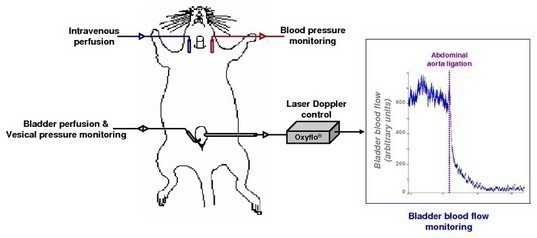Laser Doppler Flowmetry (rat / guinea pig / rabbit)
Objectives
Laser Doppler Flowmetry (LDF) is established as an effective and reliable method for the measurement of blood perfusion in the microcirculation. This method allows the demonstration of the effect of a compound on bladder regional blood flow without affecting the integrity of the tissue.
Summarized methodology
Bladder regional blood flow is measured in anesthetized animals as described in figure 1. The carotid artery and bladder are catheterized to record blood pressure (BP) and vesical pressure respectively. The jugular vein is catheterized to allow intravenous injections. A Laser Doppler flow probe is placed in contact with the bladder wall in view of establishing measurements of regional blood flow.
 |
| Figure 1: Schematic view of the experimental setting and typical recording of bladder blood flow using Laser Doppler flowmetry in anesthetized rat. |
Endpoints
- Bladder Blood flow (4-6 sites per measurement) evaluated in empty and filled bladder
- Concomitant Blood pressure and vesical pressure recording
Since this method does not affect the integrity of the bladder tissue, it could be envisaged to evaluate bladder contractility by performing cystometry experiments following the evaluation of Bladder blood flow.

Links to applicable Targeted disorders / Pathophysiological models





















 Download this page in PDF
Download this page in PDF